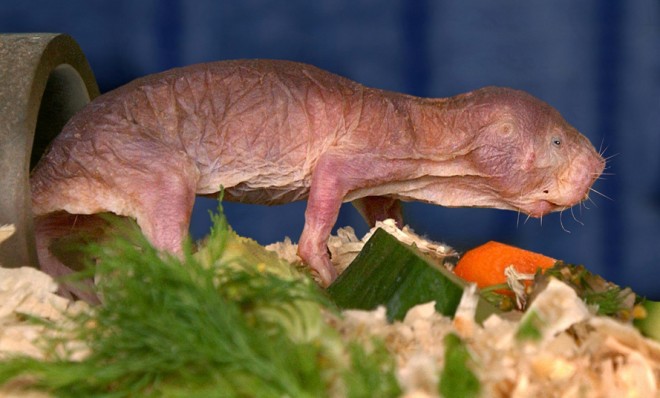The stretchy skin of naked mole rats may hold the key to fighting cancer
Their unique biology makes them immune to tumor growth

Naked mole rats are fascinating creatures, with a remarkable set of adaptations that allow them to survive in the harshest underground environments. Indigenous to East Africa, the hairless rodents spend the duration of their lives below earth's surface, where light and oxygen are scarce.
The naked mole rat's unique choice of habitat has equipped the small animal with some equally unique physiological properties: Its lungs are relatively tiny and its blood equipped with a strong affinity for oxygen, so as to improve its oxygen intake; its eyesight is greatly diminished; its skin has a curious lack of pain receptors; and it can live longer than any other rodent its size — up to 28 years.
Even the social structure of groups of naked mole rats is different by mammalian standards: Like bees and hornets, a cadre of male workers surround a single, reproductive "queen."
The Week
Escape your echo chamber. Get the facts behind the news, plus analysis from multiple perspectives.

Sign up for The Week's Free Newsletters
From our morning news briefing to a weekly Good News Newsletter, get the best of The Week delivered directly to your inbox.
From our morning news briefing to a weekly Good News Newsletter, get the best of The Week delivered directly to your inbox.
The rodent's most interesting characteristic, though, may be its incredible resiliency to deadly diseases; in fact, the naked mole rat is basically cancerproof.
In the latest issue of the journal Nature, a team of biologists from the University of Rochester analyzed the naked mole rat at a cellular level. For years, researchers have infected naked mole rats with viruses that, under most circumstances, would trigger cancer growth, at least in mice.
Not the naked mole rat, though. According to Carl Zimmer at The New York Times, "scientists have yet to find a single mole rat with cancer."
In this latest study, led by the husband-and-wife team Andrei Seluanov and Vera Gorbunova, researchers isolated the mole rat's cells in a nutrient syrup. After a few days, something weird happened: The cells transformed the surrounding liquid into a thicker syrup. "We said, 'We need to find out what this goo is,'" Dr. Gorbunova tells the Times.
A free daily email with the biggest news stories of the day – and the best features from TheWeek.com
It turns out the cells were secreting a molecule called hyaluronan, which is typically distributed in the connective tissues of mammals like humans and mice. The job of hyaluronan is to attach to a receptor cell called CD44 to deliver commands — time to multiply! time to change course!, for example.
The hyaluronan of naked mole rats turned out to be many, many times larger than what we're used to: Five times as long as the kind found in humans. This sticky goop, the authors say, may hold the key to eventually stopping cancer growth in its tracks. Scientopia explains:
It turns out, the high production of hyaluronan and the low levels of degradation are protective against the development of tumors in the naked mole rat. If you add in more enzyme to degrade the hyaluronan, the naked mole rat cells become much more susceptible to dividing and forming tumors. When the hyaluronan was [eliminated by] the cancer cells, either by stopping its formation or increasing its breakdown, the cells readily began to form tumors in mice, which suggests that the hyaluronan itself is what renders naked mole rats cancer resistant. [Scientopia]
While it's unlikely that artificially boosting hyaluronan levels in humans will stop cancer altogether, the discovery may help us attack tumors to stop their growth, says Scientopia.
And as a bonus, the presence of the tissue protein also explains why the naked mole rat's skin feels so stretchy. "If you grab an animal, it feels like you're removing their skin," Dr. Seluanov says. (Shiver.) The authors of the study think the naked mole rat's desirable ability to ward off cancer may have been an inadvertent side effect of its elasticity, allowing the rodent to lithely slink through narrow tunnels. By evolutionary standards, that's not a bad two-for-one deal.
-
 5 fairly vain cartoons about Vanity Fair’s interviews with Susie Wiles
5 fairly vain cartoons about Vanity Fair’s interviews with Susie WilesCartoon Artists take on demolition derby, alcoholic personality, and more
-
 Joanna Trollope: novelist who had a No. 1 bestseller with The Rector’s Wife
Joanna Trollope: novelist who had a No. 1 bestseller with The Rector’s WifeIn the Spotlight Trollope found fame with intelligent novels about the dramas and dilemmas of modern women
-
 Codeword: December 20, 2025
Codeword: December 20, 2025The daily codeword puzzle from The Week